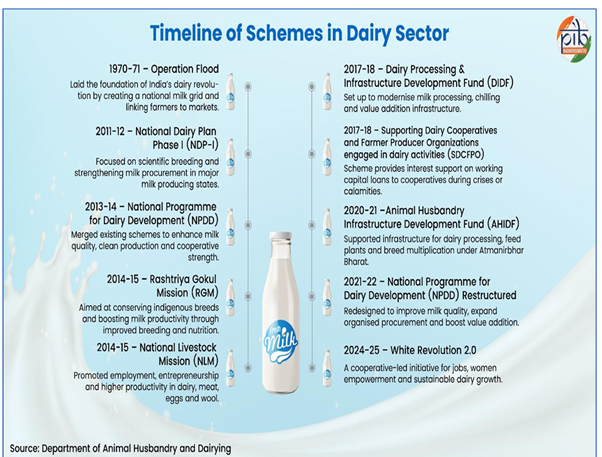1. Digital Transformation of Gram Panchayats
Context: The Ministry of Panchayati Raj (MoPR) has undertaken a series of digital reforms to strengthen Gram Panchayats, aiming to make governance faster, transparent, and inclusive. These initiatives align with Digital India and Atmanirbhar Bharat visions, empowering rural communities through technology.
Key Initiatives in Digital Governance
1. SabhaSaar – AI for Gram Sabha Meetings
-
- Launched: August 2025
- AI-powered tool that records and summarizes Gram Sabha and Panchayat meetings in real time.
- Linked with Bhashini (National Language Translation Mission) – supports 14 Indian languages.
- Ensures accuracy, unbiased records, and transparency, allowing officials to focus on governance.
2. SVAMITVA Scheme – Digital Land Mapping
-
- Launched: 24 April 2020 (National Panchayati Raj Day)
- Provides legal property ownership documents for rural households.
- Utilizes drones and advanced mapping tools for precise boundaries.
- Benefits: Enables bank loans, dispute resolution, better asset use, and improves property tax collection.
- Achievements (as of 2025):
- 2.63 crore property cards prepared across 1.73 lakh villages
- Drone surveys completed in 3.23 lakh villages
- Technology Partner: NICSI, in collaboration with Survey of India.
3. BharatNet – Rural Connectivity Backbone
-
- Launched: October 2011
- Provides high-speed internet to Gram Panchayats to bridge the digital divide.
- Services: Wi-Fi hotspots, Fibre to the Home (FTTH), mobile and digital services.
- Supports applications like GramSamvaad, Meri Panchayat, NPSS, PM Kisan.
- Status (as of June 2025):
- 6.26 lakh villages covered with 3G/4G connectivity
- 13 lakh FTTH connections commissioned
4. eGramSwaraj – Work-Based Accounting & Planning
-
- Part of e-Panchayat Mission Mode Project under Digital India
- Integrates planning, budgeting, accounting, monitoring, and online payments on a single portal.
- Achievements (FY 2024-25):
- 2.54 lakh Gram Panchayats uploaded Gram Panchayat Development Plans (GPDP)
- 2.41 lakh Panchayats completed online transactions for 15th Finance Commission grants
- Integrated with Bhashini, available in 22 Indian languages
5. Meri Panchayat App – Citizen Empowerment
-
- Developed by NIC, linked to eGramSwaraj
- Enables transparency, citizen participation, and access to Panchayat data
- Provides information on:
- Budgets, receipts, payments, GPDP projects
- Local functionaries and elected representatives
- Civic services, weather updates, grievance redressal
- Coverage: 2.65 lakh Panchayats, 25 lakh elected reps, 95 crore rural residents
- Recognition: WSIS Prizes 2025 Champion Award
6. Panchayat NIRNAY – Digital Meeting Management
-
- Real-time portal to schedule, notify, and record Gram Sabha decisions
- Replaces paper-based workflows
- Enhances participation, accountability, and transparency
7. Gram Manchitra – Geo-Spatial Planning Tool
-
- GIS-based platform for planning, mapping, and asset management
- Aligns developmental works with GPDP
- Tools for site selection, project tracking, cost estimation, and impact assessment
Recognition and Rewards
-
- National Awards for e-Governance 2025 introduced a category for Grassroots Level Initiatives
- Over 1.45 lakh entries from 26 States/UTs
- Winners:
- Gold: Rohini GP, Dhule, Maharashtra (₹10 lakh prize)
- Silver: West Majlishpur GP, Tripura (₹5 lakh prize)
Conclusion:
Digital reforms in Gram Panchayats mark a transformative shift in rural governance, making Panchayats more transparent, accountable, and citizen-focused.
2. Empowering Farmers through Skill Development and Training
Introduction
Agriculture remains the backbone of India, with nearly two-thirds of the population living in rural areas and almost half dependent on farming for their livelihood.
Why to Empower Farmers
The challenges of today’s farmers extend beyond inputs or credit. Which are climate change, soil degradation, mechanization gaps, and weak market linkages demand new skills. Recognising this, the Government of India has embedded skill development and training as a cornerstone of rural empowerment, transforming cultivators into innovators, entrepreneurs, and value-chain participants.
Key Takeaways
-
- Krishi Vigyan Kendras (KVKs): Trained 58 lakh farmers (2021–24) through demonstrations and vocational courses.
- Agriculture Technology Management Agency (ATMA): Reached 27 crore farmers (2021–25) via trainings, exposure visits, and Kisan Melas.
- Skill Training of Rural Youth (STRY): Equipped 43,000 rural youth (2021–24) in horticulture, dairy, fisheries, and allied vocations.
- Sub-Mission on Agricultural Mechanization (SMAM): Trained 57,000+ farmers (2021–25) in mechanization practices.
- Soil Health Card Scheme: Conducted 93,781 trainings and 8 lakh demonstrations on balanced fertilizer use.
Ways to empower Farmer
1. Building Institutional Platforms
-
- KVKs (ICAR initiative): Frontline extension centres bridging research and practice; trained 58 lakh farmers with year-on-year growth.
- ATMA (Extension Reforms under SMAE): Decentralised, state-led extension system; reached over 1.27 crore farmers in four years, promoting farmer-friendly practices.
2. Skilling Youth and Promoting Mechanization
-
- STRY: Short-term, 7-day vocational training integrated with ATMA; targeted youth (18+) including women; built entrepreneurial capacity in villages.
- SMAM: Expanded farm mechanization among small/marginal farmers through Custom Hiring Centres, awareness campaigns, and training.
3. Strengthening Knowledge on Soil, Resources, and Value Chains
-
- Soil Health Card Scheme: Distributed 25.17 crore cards; encouraged balanced nutrient management.
- Farmer Producer Organizations (FPOs): 10,000 FPOs promoting agri-business training, digital tools (e-NAM, GeM), and market linkages.
4. Integrating Skill Development into Flagship Schemes
-
- Pradhan Mantri Kaushal Vikas Yojana (PMKVY 4.0): Agriculture included as a priority sector; 1.64 crore trained and 1.29 crore certified till June 2025.
- Mission for Integrated Development of Horticulture (MIDH): Trained 9.7 lakh farmers (2014–24) in horticulture practices.
- Rashtriya Gokul Mission (RGM): Trained 38,736 MAITRIs to deliver doorstep AI services for livestock improvement.
- Pradhan Mantri Kisan SAMPADA Yojana (PMKSY): Human resource & skilling component created sector-specific workforce for food processing; 1601 projects approved, benefiting 34 lakh farmers.
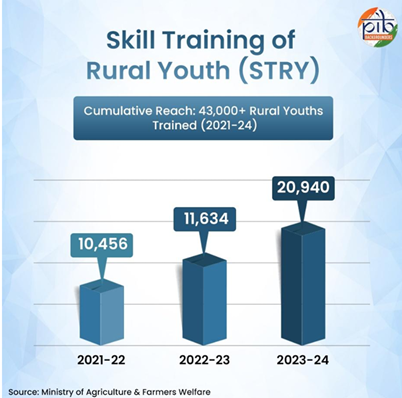
Importance of empowerment
-
- Enhances farm productivity and incomes through modern practices.
- Creates entrepreneurial farmers capable of value addition.
- Builds a resilient agricultural sector equipped to meet climate and market challenges.
- Empowers rural youth and women with employment opportunities.
Conclusion
Therefore, Skill development initiatives are not just about improving farming techniques but about building a skilled, confident, and resilient farming community.
3. GST Reforms for a New Generation
Introduction:
-
- The GST reforms introduced in September 2025 mark a landmark step in reshaping India’s taxation system.
- Objective: Simplification, affordability, competitiveness, and youth empowerment.
- Sectors with high youth participation—education, textiles, automobiles, technology, handicrafts, footwear, healthcare, food processing—prioritised for lower tax burden and growth opportunities.
Key Features of GST 2025 Reforms
1. Simplified GST Structure – Rationalisation of slabs, clarity in classification.
2. Rate Reductions (5% slab expansion) – Significant cuts in sectors like leather, footwear, textiles, handicrafts, packaging, logistics.
3. Youth-Centric Focus – Encourages entrepreneurship, startups, and MSME competitiveness.
4. Health & Education Priority – Affordable medicines, childcare products, vision correction, stationery, bicycles, and toys.
5. Ease of Living & Mobility – Lower costs for food items, cement, housing, two-wheelers, cars, buses, and fitness centres.
6. Innovation Push – Drones brought under 5% slab, encouraging Make in India & PLI synergy.
7. Preventive Health Taxation – Tobacco and related products taxed at 40% (from 28%).
Sectoral Highlights
-
- Leather & Footwear: GST down from 12% → 5% on leather products, footwear ≤ ₹2500; relief for MSMEs & young entrepreneurs.
- Wood & Eco-Friendly Products: Agro-based boards, bamboo flooring, particle boards now at 5%.
- Handicrafts: GST cut to 5% on idols, artware, candles, purses; boost to artisanal livelihoods.
- Textiles: MMF fibres & yarns down to 5%; readymade apparel up to ₹2500 at 5%. Enhances export competitiveness.
- Packaging & Logistics: Paper-based packing material at 5%; trucks at 18% (from 28%); lower freight rates.
- Healthcare: Essential medicines, spectacles, child-care products down to 5%/nil; insurance exempt; tobacco taxed higher.
- Education: Stationery GST → nil; toys & sports goods at 5%; bicycles at 5% to reduce school dropouts.
- Ease of Living: Cement 28% → 18%; small cars & two-wheelers 28% → 18%; buses at 18%; food staples exempted or at 5%.
- Drone Tech: All drones at 5% GST – clarity, parity, and sectoral boost.
Comparative View – Pre-Reform vs Post-Reform GST
| SECTOR | PRE-REFORM GST | POST-REFORM GST | IMPACT |
|---|---|---|---|
| FOOTWEAR ≤ ₹2500 | 12% | 5% | Affordable for youth, MSMEs benefit |
| MMF & YARN | 18% / 12% | 5% | Boosts textile exports, reduces anomalies |
| MEDICINES | 12% | 5% / Nil | Affordable healthcare, chronic illness relief |
| STATIONERY | 12% / 5% | Nil | Cheaper education tools, rural school support |
| TWO-WHEELERS (≤350CC) | 28% | 18% | Affordable mobility, gig economy boost |
| SMALL CARS | 28% | 18% | Supports middle-class aspirations |
| DRONES | 18% / 28% | 5% | Innovation & Make in India support |
| TOBACCO | 28% | 40% | Preventive health, discourages harmful use |
| CEMENT | 28% | 18% | Affordable housing & infra development |
| FOOD STAPLES (ROTI/PARATHA, UHT MILK, ETC.) | 5–18% | Nil / 5% | Reduced food inflation, youth affordability |
Significance
-
- Lower costs for education, mobility, healthcare, and entrepreneurship.
- Reduced compliance burden, lower input costs, higher competitiveness.
- Sectors like textiles, leather, toys, drones to absorb skilled youth.
- Affordable healthcare, childcare, food security.
- Push for eco-friendly products, preventive healthcare, and green mobility.
Conclusion:
The GST 2025 reforms embody a youth-first and future-ready tax system that balances growth, inclusivity, and sustainability. By rationalising rates, the government has addressed affordability, promoted MSMEs and startups, and incentivised healthier lifestyles. This reform not only strengthens India’s ease of living and doing business but also sets the foundation for a competitive, equitable, and innovative economy.
4. From Harvest to Home – “Building Resilient Infrastructure for Storage of Food Grains”
Introduction
India’s agricultural sector, one of the largest globally, is the backbone of the economy, ensuring food security, employment generation, and economic growth. In 2024-25, India achieved a record foodgrain production of 353.96 million tonnes, including 117.51 million tonnes of wheat and 149.07 million tonnes of rice.
Key Takeaways
-
- Record foodgrain production: 96 million tonnes (2024-25).
- FCI and State agencies hold 83 LMT Covered & CAP storage capacity for central pool grains.
- 8,815 cold storages with 21 million MT capacity preserve perishable commodities.
- PACS decentralised storage expanding: 5,937 new PACS registered; 73,492 computerized (June 2025).
- Key government schemes: Agriculture Infrastructure Fund (AIF), Agricultural Marketing Infrastructure (AMI), PMKSY, World’s Largest Grain Storage Plan.
Objectives:
-
- Cold storage and modern warehouses reduce wastage.
- Maintain buffer stocks for NFSA and PDS.
- Farmers can sell produce at optimal prices.
- Strategic buffer stocks protect against price volatility.
- Scientific storage ensures grains remain fit for consumption.
Food Grain Storage Systems in India
A. Centralized Storage
-
- Managed primarily by Food Corporation of India (FCI) and State Govt. Agencies.
- Procurement at MSP, storage in modern warehouses and steel silos.
- Supports PDS and stabilizes prices nationwide.
- Total Covered & CAP Storage Capacity:83 LMT (July 2025).
B. Cold Storage Infrastructure
-
- Preserves perishable commodities like fruits, vegetables, dairy, and meat.
- Includes pre-cooling, sorting, CA storage, blast freezing, and refrigerated transport.
- 8,815 cold storages with 18 lakh MT capacity (June 2025).
C. Decentralised Storage via PACS
-
- Village-level storage capacities: 500–2,000 MT.
- PACS function as procurement centers and Fair Price Shops, reducing transport costs.
- 5,937 new PACS registered; 73,492 computerized (June 2025).
Schemes for Strengthening Storage of Food Grains
1. Agriculture Infrastructure Fund (AIF)
-
- Medium-long term debt financing for post-harvest infrastructure.
- 73,155 crore sanctioned for 1.27 lakh projects (Sept 2025).
2. Agricultural Marketing Infrastructure (AMI)
-
- Strengthens marketing infrastructure: warehouses, godowns.
- 49,796 projects sanctioned, contributing 982.94 LMT storage capacity.
3. Pradhan Mantri Kisan SAMPADA Yojana (PMKSY)
-
- Modernizes food processing supply chain; reduces wastage; increases farmer income.
- 1,601 projects approved, 1,133 operational, adding 255.66 LMT processing capacity.
4. Capital Investment Subsidy Scheme
-
- Credit-linked subsidy: 35% (general) / 50% (NE & hilly areas) for cold/CA storages (5,000–20,000 MT).
5. World’s Largest Grain Storage Plan (Cooperative Sector)
-
- PACS-level infrastructure: godowns, custom hiring centers, processing units.
- Pilot project: 11 PACS completed; 500+ PACS identified for new construction.
6. Modern Storage & Silos
-
- Steel Silos (PPP & government-funded) to reduce post-harvest losses.
- Completed: 48 locations, 27.75 LMT; under construction: 87 locations, 36.875 LMT; tendered: 54 locations, 25.125 LMT.
7. Asset Monetization & Regional Schemes
-
- Construction on vacant FCI land: 17.47 LMT capacity across 177 locations.
- Central Sector Scheme “Storage & Godowns”: NE states and others; total allocation Rs. 484.08 crore.
- Private Entrepreneurs Guarantee (PEG) Scheme: Encourages private storage investment via government guarantee.
Conclusion
By reducing post-harvest losses, stabilizing prices, and enhancing market linkages, India ensures that every grain contributes to agricultural prosperity, rural income, and food system resilience.
5. India’s Dairy Sector – “Anchoring Nutrition and Income Security”
Introduction
India leads in global milk production, accounting for nearly a quarter of the world’s supply. The dairy sector is a key part of the rural economy and vital for food security. It is the largest agricultural product, making up 5% of India’s economy and employing over 8 crore farmers. The sector benefits more than 8 crore rural households, many small and marginal farmers, with women playing a crucial role, driving inclusive growth.
Key Takeaways
-
- India remains the world’s largest milk producer, contributing nearly 25% of global supply.
- Dairy is the largest agricultural product, contributing 5% to GDP and employing over 8 crore farmers.
- Milk production rose 56% in 10 years (146.3 million tonnes → 239.3 million tonnes).
- Per capita milk availability increased by 48%, reaching 471 g/day in 2023-24.
- In 2024-25, 55 lakh artificial inseminations (AI) were performed nationwide.

Women at the Heart of Dairy Development
-
- Women constitute nearly 70% of the dairy workforce and approximately 35% of participants in dairy cooperatives, highlighting their central role in rural livelihoods and inclusive growth.
- Across India, over 48,000 village-level women-led dairy cooperative societies operate, enabling empowerment and equitable participation in the sector.
- The NDDB Dairy Services (NDS) supports 23 Milk Producer Organisations (MPOs), of which 16 are entirely run by women, with all producer directors being women. These MPOs aggregate nearly 2 million milk producers across 35,000 villages, reinforcing cooperatives as a key pillar of dairy growth.
- The all-women Shreeja Milk Producer Organisation exemplifies this empowerment, having received the Dairy Innovation Award from the International Dairy Federation at the World Dairy Summit in Chicago, underscoring the global acknowledgment of women-led innovation in the dairy sector.
Factors Behind India’s Leadership in Dairy
India’s success is underpinned by a smallholder cooperative model that connects millions of farmers, ensuring steady incomes and improved household nutrition. Complementary government initiatives focus on breeding, feed management, animal health, training, infrastructure, and market linkages, further enhancing productivity and quality. With advances in breeding, nutrition, and health management, India is positioned to expand its share in the global dairy value chain while continuing to promote inclusive rural development through women’s active participation.
Growth of the Sector
1. Overall Production
-
- Milk production increased 56% from 146.3 million tonnes (2014–15) to 239.3 million tonnes (2023-24).
- India maintains a 7% annual growth rate, far ahead of the US, China, Pakistan, and Brazil.
2. Per Capita Availability
-
- Increased 48% over the decade, reaching 471 g/day, above the global average of 322 g/day.
3. Bovine Population & Productivity
-
- India’s 76 million bovines form the backbone of dairy production.
- Productivity growth: 39% (2014–2022), highest globally.
- Supported by Rashtriya Gokul Mission (RGM) and Livestock Health Disease Control Programme (LHDCP).
- Integration of Ayurveda and Ethno Veterinary Medicine (EVM) helps reduce antibiotic use and supports sustainable livestock health.
Key Government Initiatives
1. Rashtriya Gokul Mission (RGM)
-
- Launched 2014, revised 2025 with total allocation 3,400 crore.
- Focus: Indigenous breed development, genetic upgradation, productivity enhancement.
2. National Dairy Plan (Phase I)
-
- Farmer-centric, cooperative-based approach; received “Highly Satisfactory” rating from World Bank.
- Strengthened semen stations, AI network, bull production, and sex-sorted semen programs.
3. Artificial Insemination & Reproductive Technologies
-
- 33% of breedable bovines covered; 55 lakh AI performed (2024-25).
- 22 IVF labs, 32 million sex-sorted semen doses produced.
- Multipurpose AI Technicians in Rural India (MAITRIs): 38,736 trained over 4 years.
4. Progeny Testing & Breed Multiplication
-
- 3,747 progeny-tested bulls produced (2021–24); 132 breed multiplication farms sanctioned.
Future Vision – White Revolution 2.0
-
- Launched 2024–25, implemented till 2028–29.
- Expected milk procurement by cooperatives: 1,007 lakh kg/day by 2028–29.
- Focus areas:
1. 75,000 new Dairy Cooperative Societies, especially women-led, in uncovered villages.
2. Strengthening 46,422 existing societies.
3. Form three Multi-State Cooperative Societies (MSCS) for:
-
-
- Supply of cattle feed, minerals, and technical inputs.
- Promoting organic manure production, biogas, and circular economy.
- Management of hides, bones, and horns of fallen animals.
-
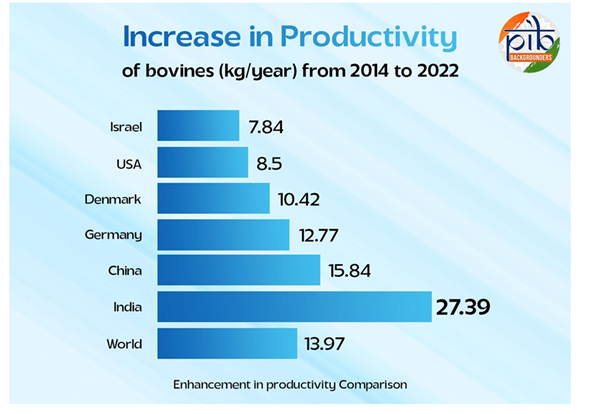
Conclusion
With the momentum of White Revolution 2.0, the sector is poised to increase productivity, empower women, create jobs, and strengthen rural prosperity, while supporting nutrition, sustainability, and global competitiveness.
6. The Indian Ports Act, 2025 – “India’s Bold Maritime Legislation”
Introduction
The Indian Ports Act, 2025 is a landmark legislation replacing the outdated Indian Ports Act, 1908, with a modern, integrated framework for port governance.
-
- Enacted in August 2025, the Act positions ports as engines of growth, employment, and strategic connectivity across India’s maritime sector.
- Act strengthens Centre-State coordination and aligns domestic practices with global standards.
- The Act aims to unlock the full potential of India’s 7,500 km coastline, boost trade, and reinforce India’s strategic maritime capabilities.
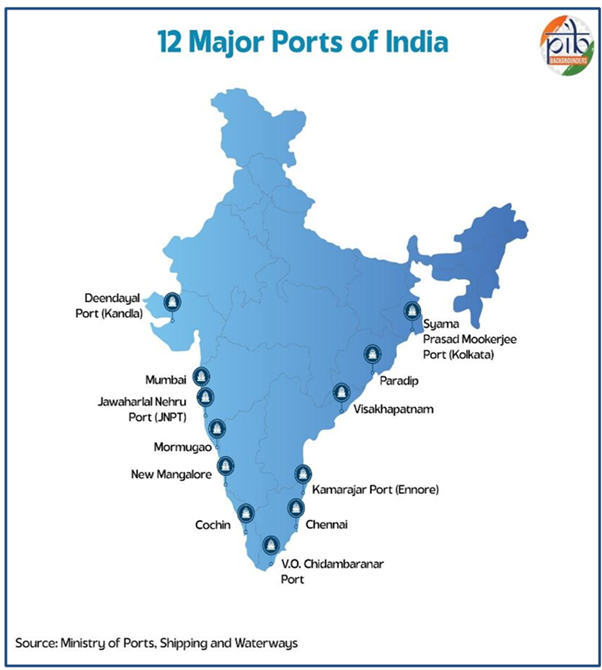
Key Takeaways
-
- Replaces the century-old Indian Ports Act, 1908, with contemporary regulations.
- Establishes Maritime State Development Council (MSDC) as a statutory consultative body for coordination between Centre and coastal States.
- Mandates compliance with Global Green Norms and Disaster Readiness at all Indian ports.
- Simplifies port procedures and digitalises operations to enhance Ease of Doing Business (EODB).
- Aligns Indian port operations with global maritime standards (MARPOL, Ballast Water Management, etc.).
Vision Behind Indian Ports Act, 2025
-
- Ports handle ~95% of EXIM cargo by volume and 70% by value, serving as critical gateways for trade and logistics.
- India has 12 major ports under the Ministry of Shipping and 200+ non-major ports under State jurisdiction.
- Major ports are fully operational; among non-major ports, ~65 handle cargo, while the rest primarily serve fishing vessels and inland waterways.
- Ports contribute to industrial corridors, employment generation, urban renewal, and regional connectivity.
- The Act promotes integrated development, cooperative federalism, and positions India as a global maritime power.
Sectoral Overhaul: Key Features of the Indian Ports Act, 2025
1. Port Officers
-
- Conservator appointed by the government acts as port officer.
- Powers include vessel movement management, fee recovery, disease control, damage assessment, and penalty adjudication.
2. Statutory Bodies
-
- State Maritime Boards (SMBs): Manage non-major ports, oversee planning, licensing, tariffs, infrastructure, and environmental compliance.
- Maritime State Development Council (MSDC): Advises the Centre on national planning, legislative reforms, port efficiency, connectivity, and data transparency.
3. Dispute Resolution Mechanism
-
- Dispute Resolution Committees (DRCs) to resolve conflicts among non-major ports, concessionaires, users, and service providers.
- Appeals go to High Court, with arbitration/alternative dispute resolution options for speedy settlement.
4. Tariff Regulation
-
- Major port tariffs set by Major Port Authority Board; non-major port tariffs by State Maritime Board or designated concessionaire.
- Tariffs must be electronically published for transparency.
5. Safety, Sustainability & Compliance
-
- Penalties for safety violations and environmental harm.
- Aligns with international conventions and mandates pollution control, disaster response, and emergency preparedness.
- Central government conducts audits to ensure compliance.
6. Digitalisation & Efficiency
-
- Initiatives include Maritime Single Window, Advanced Vessel Traffic Systems, and other tools to enhance efficiency, reduce congestion, and lower operational costs.
Issues under the Indian Ports Act, 2025
-
- No appeal mechanism is provided against penalties, unlike the Jan Vishwas (Amendment of Provisions) Act, 2023.
- Raises questions on the appropriateness and impartiality of the adjudication mechanism.
- Unclear Definition of ‘Mega Ports’.
- Conservators and health officers can enter and inspect vessels within port limits.
Comparison: Indian Ports Act, 1908 vs. Indian Ports Bill, 2025
| Feature | Indian Ports Act, 1908 | Indian Ports Bill, 2025 |
|---|---|---|
| Scope | All ports and parts of navigable rivers leading to the ports | Expanded to include all aircrafts while on water, making use of any part of the port |
| Jurisdiction | Major ports: central government, Non-major ports: state government | No change |
| Statutory Bodies | No statutory body created | Recognition for Maritime State Development Council and State Maritime Boards; requires Dispute Resolution Committees |
| Port Management | Conservator, harbour master, health officer, and other officers as notified by government | Retains all officers; conservator empowered to adjudicate penalties for certain contraventions |
| Obligations of Ports | Focused on safety, vessel regulation, defence cooperation during emergencies | Expanded to include waste reception, emergency preparedness, disaster management, and welfare of seafarers |
| Pollution Prevention | Prohibits discharging ballast water, oil, rubbish harmful to navigation | Adds compliance with International Convention for the Prevention of Pollution from Ships and Ballast Water Management Convention |
Conclusion
The Indian Ports Act, 2025, transforms ports into engines of national progress, regional connectivity, and inclusive development. It will position India’s maritime sector for global leadership and strategic growth as the country moves toward Viksit Bharat 2047.
7. National Co-operative Exports Limited (NCEL) – “Taking India’s Cooperative Strength to World Markets”
Introduction:
National Co-operative Exports Limited (NCEL) is a national-level multi-state cooperative dedicated to promoting exports. Registered under the Multi-State Co-operative Societies Act, 2002 on 25 January 2023, NCEL serves as an umbrella body representing India’s co-operative sector in overseas markets. The Act ensures democratic functioning, self-help, mutual aid, and promotes economic and social welfare of members while granting functional autonomy to cooperatives.
NCEL is promoted by five leading cooperatives: IFFCO, KRIBHCO, NAFED, GCMMF (Amul), and NCDC, with an initial paid-up capital of ₹500 crore (₹100 crore each) and authorised capital of ₹2,000 crore. By linking co-operative products to global markets, NCEL supports Make in India, strengthens market linkages, and generates employment in the co-operative sector.
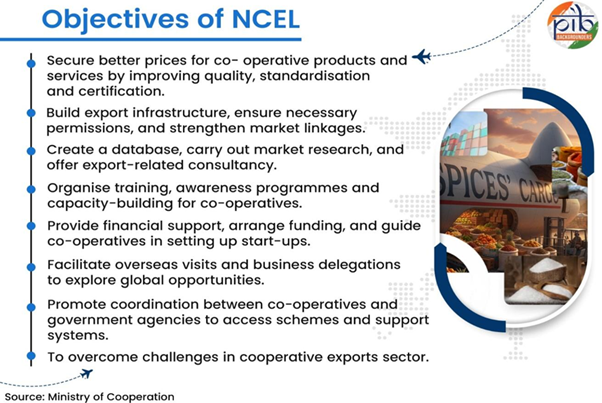
Key Achievements (as of August 2025):
-
- Membership: 11,034 cooperatives, including 10,793 PACS and other primary co-ops, 216 tehsil/district-level co-ops, 10 multi-state co-ops, 10 state-level co-ops, and 5 promoter cooperatives.
- Exports:49 lakh metric tonnes (LMT) of agricultural commodities worth ₹5,403.01 crore, including rice, onion, sugar, baby food, processed food, spices, and tea.
- Profit & Turnover: Net profit of ₹122 crore; turnover ₹4,283 crore (2024-25).
- Global Reach: Exports expanded to 28 countries; strategic MoUs signed with 61 importers in Senegal, Indonesia, and Nepal.
- Dividend: 20% dividend paid to member cooperatives (2023-24).
Export Summary (2023-25, till August):
| Year | Quantity (LMT) | Value (₹ crore) |
|---|---|---|
| 2023-24 | 2.66 | 1,113.13 |
| 2024-25 | 10.83 | 4,283.56 |
| 2025 (till Aug) | 0.00798 | 6.32 |
| Total | 13.49 | 5,403.01 |
Strategies to Expand Reach:
-
- MoUs with state nodal agencies and PACS integration.
- Commodity seminar series for farmers and cooperatives (first in Madhya Pradesh, July 2025).
- ‘Whole of Government’ approach with nodal agencies and registrar offices.
- Branding and digital outreach via social media and marketing campaigns.
- BPO Outreach Programme to boost PACS membership.
- Nukkad Natak programmes and multilingual digital newsletters in 10 languages.
Future Directions:
-
- Explore exports of sugar, aromatic rice, organic cotton, coarse grains, fresh vegetables, and special potato varieties.
- Target ₹2 lakh crore in exports; route all cooperative exports through NCEL to generate turnover of ₹20,000–30,000 crore and net profits for co-operatives.
- Establish NCEL offices in Africa and Myanmar for pulses imports.
- Develop a dedicated website to showcase co-operative supply capacity and global demand.
Conclusion:
With government support and a strong foundation, NCEL is poised to become the global face of India’s co-operatives, driving prosperity under the vision of “Sahakar se Samriddhi”.
8. World Tourism Day 2025: Tourism and Sustainable Transformation
Introduction:
Tourism enhances cultural exchange, economic growth, and global connectivity, bridging people and places while showcasing heritage and natural beauty. The World Tourism Day 2025 theme, “Tourism and Sustainable Transformation”, emphasises tourism as a catalyst for positive, sustainable change.
Host: Malaysia will host World Tourism Day and the World Tourism Conference (WTC) 2025 in Melaka from September 27–29.
History & Significance
-
- Observed annually on September 27 by UNWTO, commemorating the adoption of its statutes in 1970.
- First celebrated in 1980, highlighting tourism’s role in socio-economic growth and achieving Sustainable Development Goals (SDGs).
Tourism in India
-
- Major economic contributor: ₹15.73 lakh crore to GDP (2023-24), ~22% of economy.
- Employment: 36.9 million direct, 47.72 million indirect (~13.34% total employment).
- Inbound tourism: 16.5 lakh visitors; Outbound tourism: 84.4 lakh travellers (Jun 2025).
- Foreign exchange earnings: ₹51,532 crore.
- Medical tourism: 1,31,856 FTAs (up to Apr 2025), ~4.1% of total FTAs.
Key Takeaways
-
- India recorded ~56 lakh Foreign Tourist Arrivals (FTAs) and 303.59 crore Domestic Tourist Visits till August 2025.
- Swadesh Darshan & Swadesh Darshan 2.0: 110 projects developed across thematic circuits including Ramayana, Buddhist, Coastal, and Tribal circuits.
- SASCI Initiative (2024-25): 40 projects in 23 states sanctioned for ₹3,295.76 crore with 100% central funding.
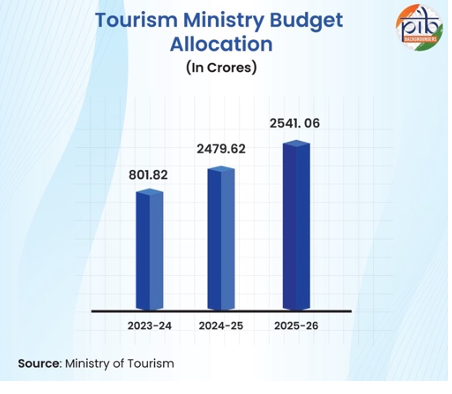
Key Initiatives
1. Swadesh Darshan Scheme
-
- Launched in 2014-15 to develop thematic tourism circuits.
- Revamped as Swadesh Darshan 2.0 (SD2.0) in 2023 for tourist- and destination-centric sustainable tourism.
- 52 projects sanctioned worth ₹2,108.87 crore in last 2 years.
-
- Sample projects:
- Andaman & Nicobar: Long Island, Havelock Island, Ross & Baratang Islands (Coastal)
- Bihar: Bodhgaya Buddhist Circuit – Convention Centre
- Himachal Pradesh: Himalayan Circuit – Manali, Shimla, Dharamshala
- Uttarakhand: Tehri Lake Eco-Tourism
- Sample projects:
2. Challenge-Based Destination Development (CBDD)
-
- 42 destinations across four themes: Culture & Heritage, Spiritual & Eco-Tourism, Amrit Dharohar, Vibrant Villages.
- 36 projects approved; to be completed by March 2026.
3. PRASHAD Scheme
-
- Pilgrimage Rejuvenation & Spiritual Heritage Augmentation Drive (2014-15).
- Focus on accessibility, security, cleanliness at pilgrimage sites.
- 54 projects sanctioned in 28 states/UTs; ₹1,168 crore approved assistance.
- Sample projects: Tripura Sundari Temple, Sri Chamundeshwari Devi Temple, Patna Sahib, Somnath, Hazratbal Shrine.
4. Dekho Apna Desh (DAD) Initiative
-
- Launched Jan 2020 to promote domestic tourism via webinars, quizzes, familiarisation tours, roadshows, and social media.
- Dekho Apna Desh People’s Choice Poll engages citizens to identify favourite destinations.
5. Vibrant Villages Programme (VVP-I & II)
-
- VVP-I (2023): Develop villages near northern borders in Arunachal Pradesh, Himachal Pradesh, Sikkim, Uttarakhand, Ladakh.
- VVP-II (2025–29, budget ₹6,839 crore): Focus on strategic villages near international land borders across 17 states/UTs.
6. SASCI Scheme (Special Assistance for Capital Investment)
-
- Launched July 2025 for iconic tourist sites; full central funding.
- 40 projects sanctioned worth ₹3,295.76 crore, completion by March 2026.
7. Capacity Building for Service Providers (CBSP)
-
- Paryatan Mitra/Paryatan Didi initiative empowers local communities, women, and tribal groups.
8. Incredible India Digital Portal & Content Hub
-
- One-stop digital travel solution, enhancing planning, booking, and travel experience.
- Features: Book Your Travel, AI-powered chatbot, multimedia content, itineraries.
- Content Hub: high-quality images, films, brochures for global stakeholders.
9. One India, One Registration (NIDHI Portal)
-
- Homestays classified into Gold & Silver categories.
- States/UTs eligible for up to ₹5 crore for clusters of 5–6 villages.
- Collateral-free Mudra loans available to encourage rural and tribal homestays.
10. Tribal Tourism Circuit
-
- Tribal home stays supported with funding for village requirements, new rooms, and renovation.
11. MICE Tourism
-
- Development of Meetings, Incentives, Conferences, Exhibitions
- Iconic venues: Bharat Mandapam, Yashobhoomi, Jio World Centre.
- India currently captures 5% of USD 850 billion global market, targeted to expand.
12. Sub-sector Enhancements
-
- Festival Tourism: Utsav Portal
- Adventure Tourism: 120+ new peaks for mountaineering/trekking
- Wedding Tourism: “India says I do”, “Wed in India” campaigns
- Cruise Tourism: 51 new cruise circuits planned under Cruise Bharat Mission (2024–29)
- Pilgrimage Tourism: PRASHAD & Swadesh Darshan improvements
- Medical Tourism: “Heal in India” initiative; private sector partnerships
Conclusion:
Tourism in India has grown remarkably, contributing to economic development, employment, and cultural diplomacy.
Spread the Word
